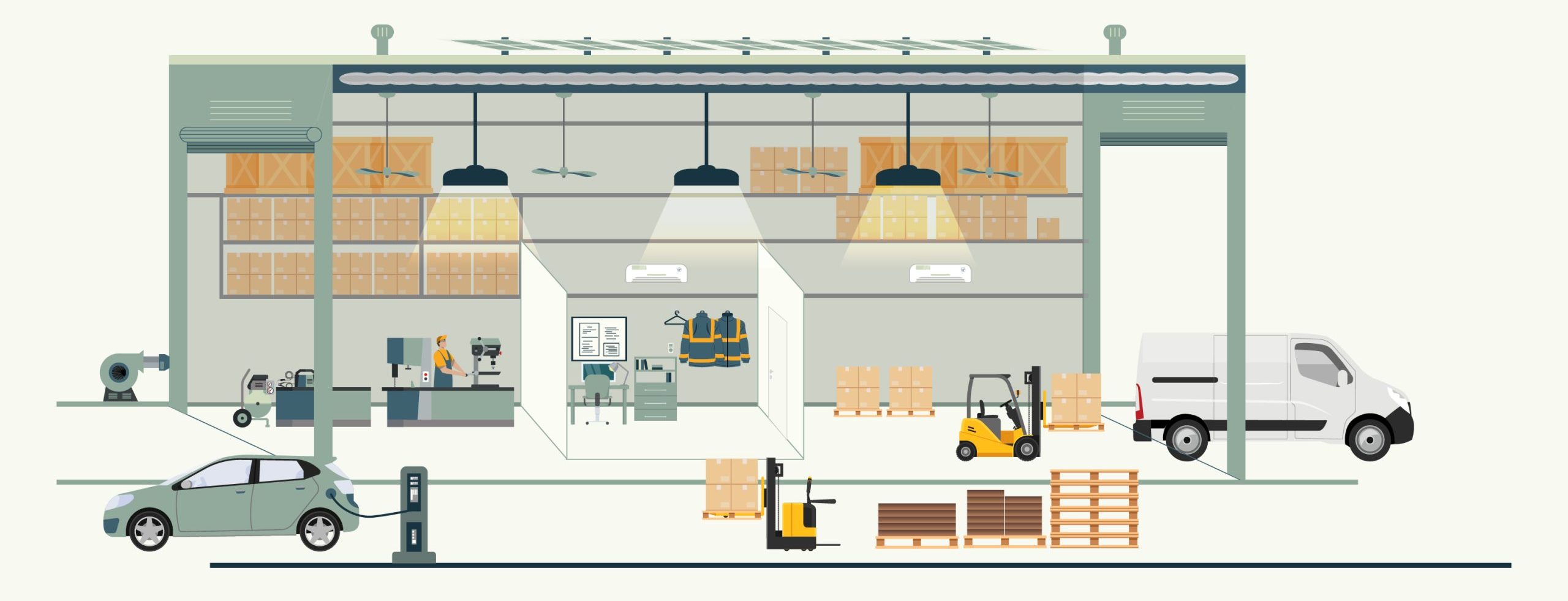Small Manufacturing

 Heating and Cooling
Heating and Cooling Heating and Cooling
Your business can implement various strategies to enhance energy efficiency in your heating and cooling systems while ensuring comfort in your workspace.
 Lighting
Lighting Lighting
Most warehouses will likely have high bay lighting, and possibly some low bay fluorescent lighting in any office or retail areas, both of which can be upgraded to LED. Ensure low use areas such as toilets are on motion sensors.
 Pumps and Fans
Pumps and Fans Pumps and Fans
The ability to control motor speed and torque with precision enables businesses to save energy while optimising productivity and product quality.
 Insulation
Insulation Insulation
Insulation plays a pivotal role in optimising energy efficiency and maintaining comfortable working conditions within small manufacturing facilities.
 Solar PV
Solar PV Solar PV
Solar photovoltaic (PV) systems are a powerful asset for small manufacturing businesses, harnessing sunlight to deliver sustainable solar power to hospitality establishments.
 EV Fleet
EV Fleet Electric Vehicle
EVs offer sustainable and cost-effective solutions, encompassing a diverse range of vehicles such as cars, trucks, and even forklifts, powered by electricity stored in batteries.
 EV Fleet
EV Fleet Electric Vehicle
EVs offer sustainable and cost-effective solutions, encompassing a diverse range of vehicles such as cars, trucks, and even forklifts, powered by electricity stored in batteries.
 Office Space
Office Space Office Space
Many manufacturing facilities have a small office space, which might have different energy requirements to the main space.
![]() Click on each icon in the image above to get instant tips
Click on each icon in the image above to get instant tips
Small manufacturing businesses encompassing sectors like food and beverage production and boutique breweries, often face significant energy demands, especially for refrigeration, lighting, heating and cooling. With diverse operations, these businesses engage in mixed-use manufacturing, where efficient energy management becomes pivotal for sustainable and cost-effective operations. Addressing the energy-intensive nature of these environments is essential for optimising production processes while minimising overall energy consumption and expenses.
Heating and Cooling
Your business can implement various strategies to enhance energy efficiency in your heating and cooling systems while ensuring comfort in your workspace. The first thing to consider is maintaining a comfortable temperature through effective insulation.
Other tips and upgrades to improve heating and cooling energy efficiency include:
- Heated jackets for employees working in colder environments can reduce the reliance on excessive heating.
- Installing radiant electric heat panels (infrared type are best) at key locations within the workspace can provide targeted warmth, optimising energy usage by focusing heat where it's needed most.
- For cooling, employing large fans and evaporative cooling systems used together can effectively regulate temperatures in most small manufacturing settings.
- Large fans aid in air circulation, providing up to 6 degrees in cooling effect for staff and promoting ventilation and cooling without consuming excessive energy.
- Evaporative cooling, an energy-efficient alternative to traditional air conditioning, can significantly lower indoor temperatures by utilising the natural process of water evaporation; though it’s important to note that evaporative cooling does use water and only works in low humidity conditions, making it a good option for keeping industrial warehouses cool during Victorian summers (when it’s not humid).
- For both heating and cooling, it is important to set the thermostat within sensible limits (18-20°C during winter, 23-25°C during summer) and ensure the system is switched off outside work hours.
- Thermostats should be placed to reflect internal temperatures only - they should be positioned to avoid influence from external temperatures or other sources of heat or cold, such as on internal walls or away from open doors.
- Consider using reversible fans to assist in cooling and push warm air back to where it's needed in winter.
- Mitigating heat gain from direct sunlight exposure can be achieved by shading large thermal mass areas, such as tilt slab concrete walls, with strategically placed plantings of trees or large shrubs. This natural shading helps reduce the heat absorption of the building's structural elements, which minimises the need for additional cooling.
- Apply a heat reflective paint on the concrete walls. This approach proves especially effective for west-facing areas, ensuring a more temperate indoor environment.
Implementing a combination of these measures tailored to the specific needs and layout of the manufacturing space can significantly reduce energy consumption for heating and cooling purposes while fostering a comfortable and productive work environment.
Pumps and Fans
Variable Speed Drives (VSDs) for pumps and fans can cut motor energy usage substantially, offering precise control over the speed and torque of electric motors to match the required load. Reducing motor speed by 20% can reduce power required by 50%. By dynamically adjusting the motor's operating speed based on the actual workload, VSDs optimise energy consumption and reduce unnecessary energy wastage associated with fixed-speed motors. In manufacturing processes where machinery operates at varying speeds and capacities, VSDs enable a more efficient and tailored approach to energy utilisation.
In addition to energy efficiency, VSDs offer several other benefits in small manufacturing. They contribute to a smoother operation of equipment, reducing vibrations and improving overall precision in manufacturing processes. The ability to control motor speed and torque with precision also enhances process control and flexibility, enabling businesses to optimise productivity and product quality.
Electric Vehicle Fleet
Electric Vehicles (EVs) are revolutionising transportation and logistics in small manufacturing businesses, offering sustainable and cost-effective solutions for various purposes such as commuting, cargo transport and internal operations. EVs encompass a diverse range of vehicles, including cars, trucks, and even forklifts, powered by electricity stored in batteries.
Their adoption in small manufacturing environments presents numerous benefits, including reduced carbon emissions, lower operational costs, and enhanced operational efficiency. Moreover, the lower maintenance requirements of EVs compared to internal combustion engine vehicles result in reduced maintenance expenses over their lifespan, providing long-term cost savings for businesses.
For manufacturing operations involving material handling, electric forklifts offer an eco-friendly alternative to their diesel or propane counterparts. Electric-powered forklifts operate silently and produce zero emissions, making them suitable for indoor use without the risk of air pollution. Additionally, their lower operational noise levels contribute to a quieter work environment.
Implementing EV charging infrastructure within small manufacturing facilities is crucial to support the transition to electric transportation. Installing charging stations allows employees to conveniently charge EVs during work hours, ensuring an uninterrupted workflow and promoting employee adoption of sustainable commuting options.
In addition, the integration of smart charging systems enables optimised energy usage, allowing for efficient charging of business vehicles during off-peak hours when electricity demand is lower. If your business also installs solar PV, this can be a great way to make use of the daylight hours and essentially run your vehicles for free.
Insulation
Insulation plays a pivotal role in optimising energy efficiency and maintaining comfortable working conditions within small manufacturing facilities. Adequate insulation tailored to the local climate not only minimises heat transfer, but also significantly reduces the reliance on heating and cooling systems, offering substantial energy savings and cost efficiencies for businesses.
In Melbourne's climate, recommended R-values (i.e. thickness) for insulation typically range from R4.5 to R6.0 for ceiling insulation and between R1.5 to R2.5 for wall insulation, depending on the specific requirements of the building and its usage. By installing insulation with these recommended R-values, small manufacturing warehouses can effectively mitigate heat transfer through the building envelope, thereby reducing heat gain in summer and heat loss in winter.
Retrofitting insulation to a commercial warehouse can be challenging without removing roof and wall sheeting, but roof blankets and wall aircell foam insulation can be used. Office areas within the premises can often easily retrofit insulation batts to suspended ceilings.
Properly insulated warehouses create a thermal barrier that helps maintain consistent indoor temperatures, lessening the need for extensive heating during chilly winters and excessive cooling in hot summers. Consequently, businesses can experience lower energy bills while reducing their carbon footprint by decreasing energy demand and associated greenhouse gas emissions.
Solar PV
Small manufacturing sites usually have the benefit of clear and large expanses of roof space which is ideal for solar PV. There are also a variety of no upfront cost funding mechanisms for businesses such as solar leasing, environmental upgrade agreements and energy efficiency improvement loans from financial organisations.
Most roofs that are structurally sound, and unshaded, are suitable for hosting rooftop solar. You can get a quick free quote for solar PV from multiple suppliers, ensuring to take into account your current and future electricity usage.
There are various solar calculators available, such as the solar and battery storage sizing and payback calculator from Sunspot. Solar system sizing is flexible. Where funds are limited a smaller system is a worthwhile measure to cut emissions and running costs. A larger system can also be worthwhile, to accommodate future electrical loads. Additionally, the rebates are reducing over time, so the sooner you install it the better to start enjoying the benefits of solar PV.
If you rent the premises for your business, you will need to speak with the building owner about how you can work together to install a solar PV system. For more information, see Making a Plan.
